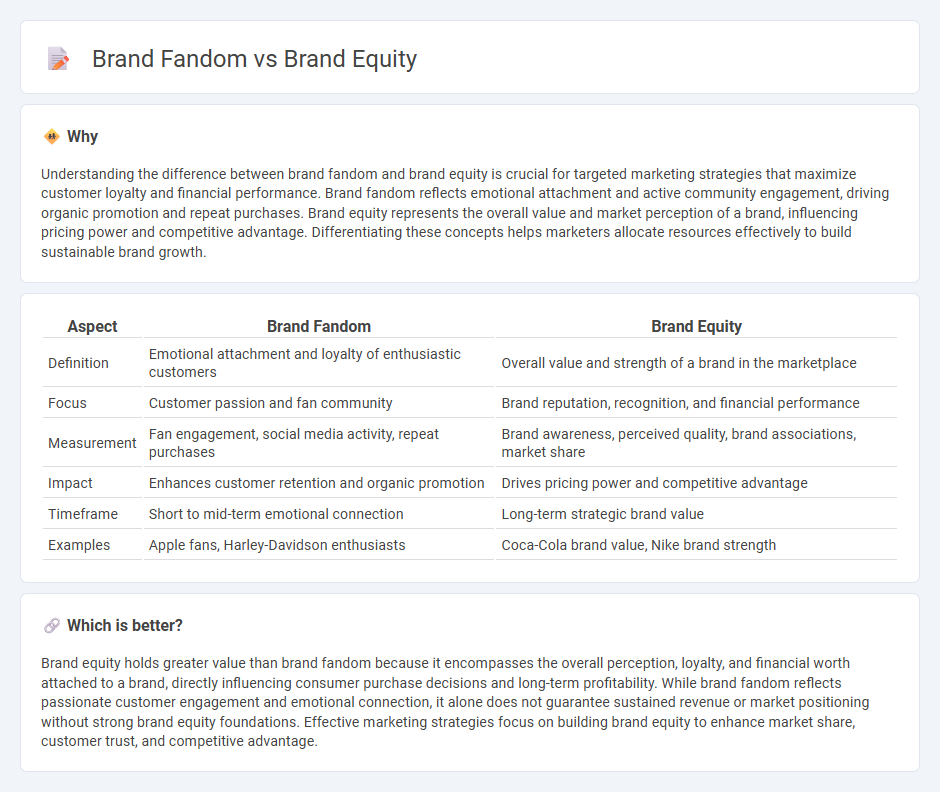
Brand fandom reflects strong emotional connections and loyalty enthusiasts have toward a brand, driving advocacy and repeat engagement. Brand equity quantifies the overall value derived from consumer perception, reputation, and market influence, impacting pricing power and competitive advantage. Discover how leveraging brand fandom can significantly enhance brand equity in your marketing strategy.
Why it is important
Understanding the difference between brand fandom and brand equity is crucial for targeted marketing strategies that maximize customer loyalty and financial performance. Brand fandom reflects emotional attachment and active community engagement, driving organic promotion and repeat purchases. Brand equity represents the overall value and market perception of a brand, influencing pricing power and competitive advantage. Differentiating these concepts helps marketers allocate resources effectively to build sustainable brand growth.
Comparison Table
| Aspect | Brand Fandom | Brand Equity |
|---|---|---|
| Definition | Emotional attachment and loyalty of enthusiastic customers | Overall value and strength of a brand in the marketplace |
| Focus | Customer passion and fan community | Brand reputation, recognition, and financial performance |
| Measurement | Fan engagement, social media activity, repeat purchases | Brand awareness, perceived quality, brand associations, market share |
| Impact | Enhances customer retention and organic promotion | Drives pricing power and competitive advantage |
| Timeframe | Short to mid-term emotional connection | Long-term strategic brand value |
| Examples | Apple fans, Harley-Davidson enthusiasts | Coca-Cola brand value, Nike brand strength |
Which is better?
Brand equity holds greater value than brand fandom because it encompasses the overall perception, loyalty, and financial worth attached to a brand, directly influencing consumer purchase decisions and long-term profitability. While brand fandom reflects passionate customer engagement and emotional connection, it alone does not guarantee sustained revenue or market positioning without strong brand equity foundations. Effective marketing strategies focus on building brand equity to enhance market share, customer trust, and competitive advantage.
Connection
Brand fandom amplifies brand equity by fostering deep emotional connections and long-term loyalty among consumers, which enhances perceived value and market strength. Loyal fans actively promote and defend the brand, increasing its reputation and customer lifetime value. This heightened engagement drives higher sales, premium pricing, and competitive advantage, directly boosting overall brand equity.
Key Terms
Perceived Value
Brand equity measures the overall value and strength of a brand in consumers' minds, heavily influenced by perceived quality, trustworthiness, and emotional connection. Brand fandom, however, centers on passionate loyalty and active engagement from devoted customers who not only value but advocate for the brand. Explore the key differences and how perceived value drives both concepts to enhance brand strategy effectiveness.
Emotional Connection
Brand equity measures the overall value a brand holds in the market through consumer perceptions, recognition, and loyalty, often driven by consistent quality and trust. Brand fandom dives deeper into emotional connection, where consumers develop a passionate attachment and engage with the brand on a personal level, manifesting through advocacy and community participation. Discover how cultivating brand fandom can transform traditional brand equity into a thriving, emotionally connected audience.
Community Engagement
Brand equity measures the overall value and reputation a brand holds based on consumer perceptions, whereas brand fandom represents an active, passionate community deeply engaged with the brand's identity and culture. Community engagement enhances brand fandom by fostering interactions, loyalty, and shared experiences that transform passive customers into enthusiastic advocates. Discover effective strategies to leverage community engagement for building both strong brand equity and vibrant brand fandom.
Source and External Links
What Is Brand Equity? How To Build Brand Equity (2025) - Brand equity is the market strength or value of a brand based on people's perceptions, influencing customer loyalty and pricing power, and can be built over time through quality experiences and consistent marketing efforts.
Brand Equity Guide - Brand equity is the value of a brand reflected in consumer perception and can be developed by building brand awareness, communicating brand meaning, fostering positive responses, and creating meaningful customer relationships.
Brand Equity: What It Is, Why It Matters & How to Build It - Brand equity is the value customers assign to a business based on perceived quality, delivering financial benefits like higher pricing power, stronger loyalty, increased trust, and better resilience in the marketplace.
 dowidth.com
dowidth.com